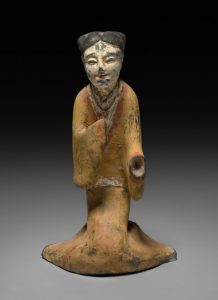23 Fox Spirits
Foxes and Women in Imperial China
Anna Mirsky
Overview
As one of the creatures most central to Chinese mythology, foxes are an extremely significant part of Chinese culture. Myths about foxes span many dynasties, changing over time but remaining popular. In fact, there is an entire genre of fox stories, all of which share some common themes but which portray foxes and fox spirits in very different ways. The number of varying and often contradictory accounts of foxes demonstrates their complex role in imperial China. Foxes were described by different authors as devious and clever, virtuous and honorable, or cruel and vengeful. They were worshipped by some and feared by others. Because tales of foxes were influenced by the broader culture of the empire and the events occurring over time, these myths also serve as reflections of Chinese society. Additionally, because so many fox stories are focused on women, they are especially useful in providing insight into the role of women throughout the dynasties of imperial China. In this chapter we will look at the common ideas surrounding fox spirits and examine how fox stories reflect the societal structure of late imperial China, with a particular focus on the representation of women.
The Nine-Tailed Fox
As early as the Xia dynasty (a semi-historical period believed to have existed from 1200-1600 BCE), foxes were actually seen as omens of good fortune, particularly in the political realm. The sighting of a nine-tailed fox was meant to signify that the empire was under the control of a strong and competent leader. Yu the Great, the mythical founder of the Xia dynasty, was said to have been visited by a nine-tailed fox, foretelling the success of his future marriage and the prosperity of the empire under his rules.[1] Because of their various associations with the prosperity of the empire, foxes of unusual size or color were often sent to court as a tribute to the current emperor, a tradition that continued into the late Han dynasty (206 BCE-220 CE). Foxes were also thought to embody moral values and lessons.[2] According to Confucian scholars in the late Han dynasty, “When a fox dies, it turns its head toward the hill [where it was born]; it does not forget its [place] of origin.” This statement emphasizes the importance of observing the rituals of one’s home in relation to death and spirituality. This was extremely important particularly in the Han dynasty, as the ideas surrounding death changed drastically around this time. Confucian scholars also compared the tails of the nine-tailed fox to the nine concubines of the emperor: “Why must [this fox appear] with nine tails? When the nine concubines [of the King each] recieve their proper place, his sons and grandsons will enjoy abundant peace. Why [is the emphasis laid] upon the tail? It is to indicate that his posterity shall be numerous.”[3] Essentially, order and harmony among the emperor’s concubines was necessary to maintain the stability of the royal household. Concubines were also essential to ensuring the emperor’s legacy. Yet this statement also demonstrates the lower position of women in imperial China as compared to men of their same social status. Even women of the royal household needed to be kept in “their proper place” for everything to function smoothly.

Fox Spirits in Human Form
While the nine-tailed fox was typically a positive omen, other fox spirits, particularly later on in Imperial China were portrayed as clever and malevolent tricksters. According to popular belief, once a fox was fifty years old, it could take part in a ritual through which it could obtain human form. The fox in question must find a skull to wear over its head. If the fox could shake its head without the skull falling off, it would transform into a beautiful woman or man.[4] Once in human form, fox spirits would take advantage of mortal humans, seducing them for their own gain, taking up residence in houses and creating disturbances, and exacting cruel revenge on any who happened to offend them. However, there are several exceptions to this general rule. Some stories describe fox spirits as having a strong sense of honor. When treated with respect they could be quite generous, often rewarding those who assist them. The common view of foxes also varied based on the gender of the fox in question. While both male and female fox spirits were known to exist, most tales dealt with fox women. These stories therefore offer a look into the lives of women in imperial China and what their role was in society.[5]

Fox Women as Succubae
Fox spirits supposedly had an excess of yin energy, leading them to be most commonly associated with and depicted as women. As yin was also the force associated with darkness and evil, so fox women were regarded as devious and manipulative. Fox women were by and large portrayed as succubae, using their unnatural beauty to lure men in. A fox who successfully seduced a man would then feed off the man’s yang energy in order to balance out her own yin energy, risking his health in the process. The longer a man carried on an affair with a fox woman, the weaker he would grow, to the point where he was at risk of dying. Equally dangerous were scorned fox women, who may cut the hair of the men who had offended them while they slept (hair was thought to contain a person’s life force).[6] These stories provide an interesting commentary when taken in the context of the social order at the time. The power that fox women had over men would have been an inversion of social norms. In Imperial China, a man of the same status as a woman would have power over her, particularly if they were involved in any sort of romantic or sexual relationship. In marriage especially, a man being subservient to his wife would have been a huge issue. The loyalty of a son to his parents was prized over his devotion to his wife. A man would have been condemned for prioritizing his wife rather than caring for his parents as was his (and his wife’s) duty.[7] With this in mind, stories of fox women leading men astray function as a warning of sorts, placing emphasis on the dangerous power of feminine beauty and sexuality. The risk of a man’s demise due to his involvement with a fox woman is as much a result of her evil as it is a result of an upset in the power structure.
Fox Women as Lovers
Despite the many references to fox women as malicious beings, there exist a few stories in which quite the opposite is true. In these tales, fox women serve as examples of kindness and virtue, even functioning as the “ideal woman.” One of these stories is “The Tale of Miss Ren”, a fox woman who becomes romantically involved with a man named Zheng. Not only does Miss Ren defy the stereotype of devious and demonic fox women, but she is celebrated as the embodiment of female virtue. After her untimely death, the author recording this story laments that she was recognized only for her beauty and not for her character: “In her ability to protect her chastity in the face of violence and to remain faithful to her lord to death, she was superior to many of her sex among mankind today.”[8] The virtues Miss Ren is prized for relate only to her interactions with other men. This is consistent with the idea during early Imperial China that women were symbols of a man’s status. The same reasoning existed behind the objections to the remarriage of widows, which was thought to bring dishonor to the first husband and family of a remarried woman. In fact, a woman who fervently resisted remarriage (some through methods extreme as suicide) would have been celebrated as a “martyr to chastity.”[9]

Fox Men
Though people also believed male foxes also existed during Imperial China, they appeared in popular culture far less often than their female counterparts. Additionally, encounters with fox men often played out very differently. Fox men were very rarely sexualized and typically appeared as father figures or scholars. There are several stories of fox clans seeking temporary lodging in the homes of villagers, in which case a fox man will be the one to negotiate with the host, as the head of his family.[10] In another well-known story, “Grace and Pine,” belonging to Pu Songling’s collection of supernatural tales, an educated young man by the name of Kong meets a fox (in human form) staying in an abandoned mansion. The fox’s father hires Kong to tutor his son, who then arranges for Kong to marry into their family. In this example, the fox men act as the agents that enable Kong to meet the fox woman and fall in love.[11]
In the rare instance in which a fox man seduced a human woman, he would typically manifest as a noncorporeal, parasitic spirit rather than a physical being. Though the victim of a male fox spirit would often claim to be able to see him, those around her would not. She would therefore be discredited, and her behavior deemed a product of insanity induced by possession. As such, relationships between human women and fox men never ended well. The fox spirit would be exorcised and subsequently banished or, more often than not, killed. One reason fox men were less sexualized than fox women is the fact that most of these stories came from men in a largely heteronormative society. Therefore there would have been a much greater interest in portraying the dangers and benefits of female beauty and sexuality.[12]
Bibliography
Hinsch, Bret. Women in Early Imperial China. Plymouth: Rowman and Littlefield Publishers, 2011.
Huntington, Rania. Alien Kind: Foxes and Late Imperial Chinese Narrative. Harvard East Asian Monographs, 222. Cambridge, Mass.: Harvard University Asia Center, 2003.
Kang, Xiaofei. The Cult of the Fox : Power, Gender, and Popular Religion in Late Imperial and Modern China. Columbia University Press, 2006.
Pu Songling. “Grace and Pine” In Strange Tales from a Chinese Studio, translated by John Minford, pp.76-86. Penguin Classics. London: Penguin, 2006.
Shen Jiji. “Miss Ren, or the Fox Lady” (Renshi zhuan) In An Anthology of Translations: Classical Chinese Literature. Vol. 1: From Antiquity to the Tang Dynasty. Edited by John Minford and Joseph S. M. Lau, 1024-1032. New York: Columbia University Press, 2000.
- Xiaofei Kang, The Cult of the Fox : Power, Gender, and Popular Religion in Late Imperial and Modern China (New York: Columbia University Press, 2006), 15. ↵
- Kang, The Cult of the Fox , 16-17. ↵
- Kang, The Cult of the Fox, 15-16. ↵
- Kang, The Cult of the Fox, 18. ↵
- Rania Huntington, Alien Kind: Foxes and Late Imperial Chinese Narrative (Cambridge: Harvard University Asia Center, 2003). ↵
- Kang, The Cult of the Fox, 19. ↵
- Bret Hinsch, Women in Early Imperial China (Plymouth: Rowman and Littlefield Publishers, 2011), 51-54. ↵
- Shen Jiji, “Miss Ren, or the Fox Lady” (Renshi zhuan), In An Anthology of Translations: Classical Chinese Literature. Vol. 1: From Antiquity to the Tang Dynasty, edited by John Minford and Joseph S. M. Lau (New York: Columbia University Press, 2000), 1024-1032. ↵
- Hinsch, Women in Early Imperial China, 44-48. ↵
- Huntington, Alien Kind, 113-123. ↵
- Pu Songling, “Grace and Pine,” In Strange Tales from a Chinese Studio, translated by John Minford, Penguin Classics (London: Penguin, 2006), 76-86. ↵
- Huntington, Alien Kind, 204-211. ↵
